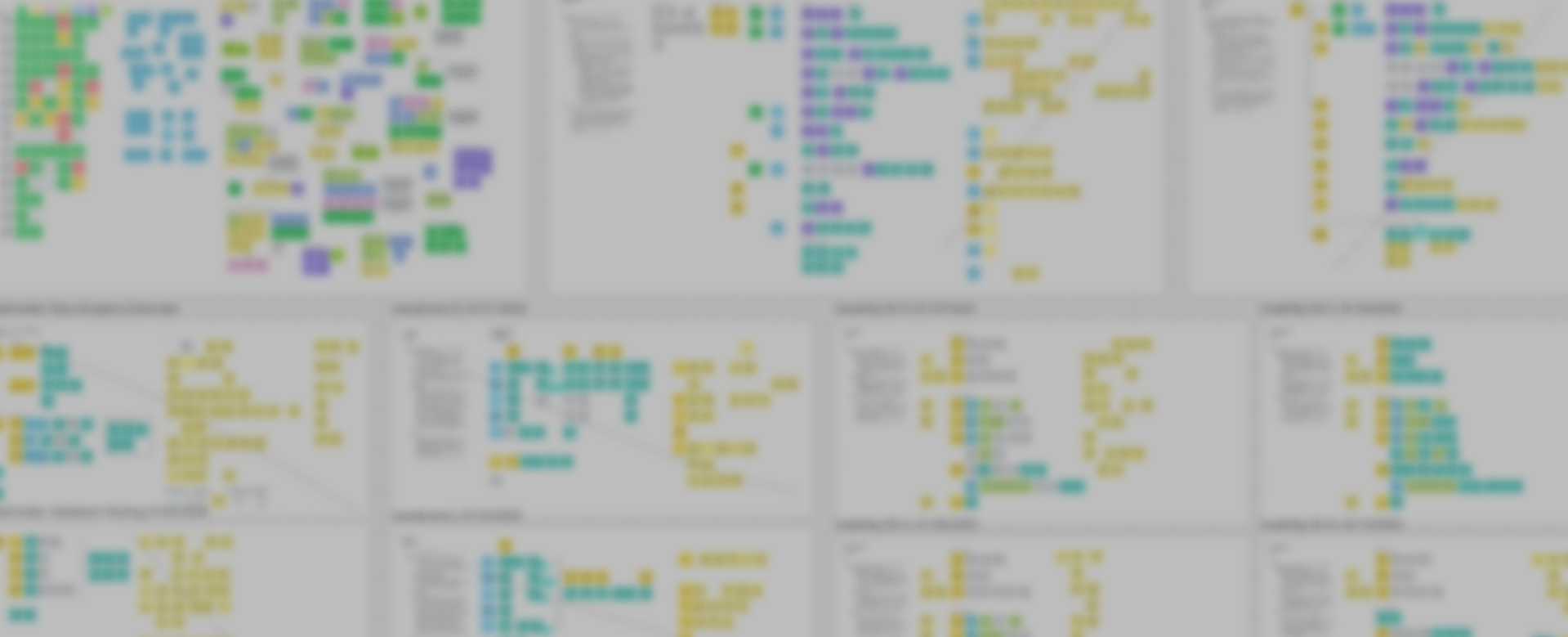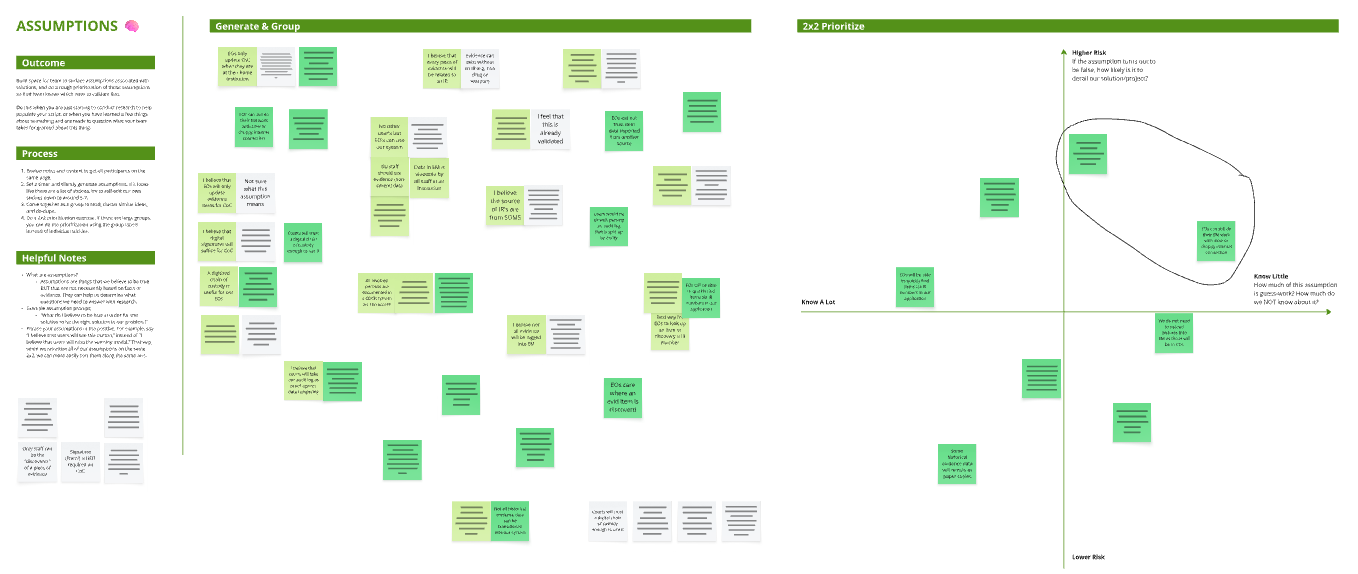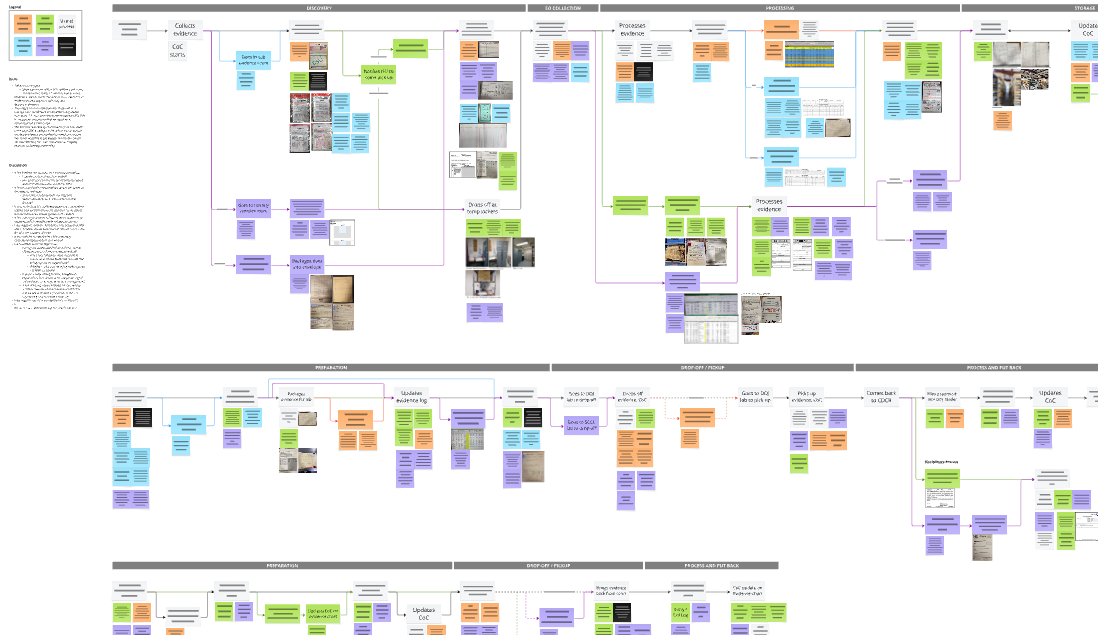MISSION - Design and deliver a progressive web application (PWA) solution to modernize and standardize the evidence collection, process, and management process so that officers have an easier (and faster) time doing their work and leadership has better data to make informed decisions
TIMEFRAME - April 2024 - May 2025
CLIENT - A major state department of corrections and rehabilitation
ROLE - Product designer / consultant, pairing with a junior client product designer collaborating with team of product managers and software engineers
SITUATION
Everyday in a state prison, items can turn up virtually anywhere accessible to the facility’s population. Sometimes it is a shirt belonging to an incarcerated person (IP) that simply got misplaced, and sometimes it is a baggy of dangerous drugs that would need to be carefully handled and its discovery thoroughly investigated. Proper collection, processing, storage, and tracking of these items that turn up in a prison is critical, because if those items are found to be related to an IP’s case, they become evidence that sways the verdict one way or another. The corroborative record for those items ensures that the correctional staff involved have not tampered with them. Plus, for institutions trying to curb the flow of drug contraband smuggled into the population and address problems with violence and overdoses, being able to monitor trends of contraband discoveries over time means that staff can quickly respond to short-term spikes with different search techniques and long-term patterns with re-allocating resources toward better IP support and programming.
At the state prison system that was our client, this was the situation for each of the 60+ institutions and camps. For the vast majority of locations, the status quo was something that looked like it could be from the 1900s: paper or plastic bags used to collect the item with hand-scribbles of some discovery details, numerous log books where a record needed to be logged every time the item changes custodian or storage, and file cabinets or archive closets filled with tens or hundreds of three-inch binders full of past logs of items dating back to when each facility was established. Mistakes were common because of problems with legibility and lost context (because a piece of detail was missed early on), resulting in cases being dismissed in courts, staff getting disciplined for non-compliance, and the whole prison system failing public audits.
Furthermore, officers wasted a lot of time searching through binders for information about items when they were subpoenaed for court processes, and they wasted even more time when leadership requested for data on patterns of contrabands found at different institutions, because now they had to comb through multiple binders of logs to try to distill insights. Wardens often had to rely on their own memories (or those of their subordinates) when making decisions about operations at their facility, and without good data to back up these decisions, they risk not being able to act quickly, misremembering information, or introducing their own biases. Since processes (and therefore data) might be different from institution to institution, it was a challenge aggregating data across the whole agency, making data-driven decisions at a department-level even more challenging.
Prior to the Evidence Management app, evidence records were managed by hand on physical sheets of paper or envelopes that were then filed into one of many giant binders.
TASK
Our team was brought on to address these systemic issues of evidence management at this state department of corrections and help bring them into the 21st century. Early on, I worked with the PM to plan and facilitate project kickoff with a goals-alignment workshop to identify what we wanted to achieve at a high level for the project. We identified the top-priority outcomes for the project to be:
- Evidence management process and data is standardized across all institutions in the state
- All evidence officers (staff who are primarily responsible for processing and maintaining the logs of items found) can do all of their work using our digital solution
- Decision-makers has readily access to evidence item data to make data-driven financial, operational, and policy decisions
- Our client team is trained and prepared to continue iterating and maintaining the product after the engagement ends
The last outcome on the list was specific to our Tanzu/Pivotal Labs process of pairing. When we join an engagement, we are often staffed in pairs with a counterpart on our client team: one Labs product designer working with a client (often junior or non-) designer, one Labs PM working with a client PM or analyst learning to be a PM, and Labs engineers working with a corresponding number of client engineers. The work style is derived from pair programming, where we would work alongside each other as a pair, whether in real-life at the same computer station or virtually on the same conference call, for the majority of the day. It can be tiring, but it is also an exhilarating way of intense collaboration, where decisions are made with two brains (often one with expertise in the process/technique, and the other more experienced in or familiar with the domain) and the junior practitioner rapidly upskills. After all, what better way is there to train someone than to have them do an entire, actual project with an industry expert!
ACTION
To start, I collaborated with our PM to plan and execute a 6-week long Discovery and Framing (D&F) phase to identify the most mission-critical problems to address and draft a solution direction to begin iterative development. Through collaborative workshops and in-depth user research interviews with evidence officers from 4 representative institutions and with multiple stakeholder groups, the team aligned with our stakeholders and users on business objectives and project priorities; mapped out end-to-end user journeys and workflows/blueprints for the discovery, collection, processing, recording, and management of evidence items; facilitated risk and mitigation workshops to identify areas of highest risk to the mission of the agency as well as opportunities for design improvement; aligned on the most valuable functionalities for the team to address; and developed and validated early solution prototypes with users of the application.
One of the D&F workshops I facilitated involved asking our participants to generate assumptions about the product space and prioritize those assumptions based on confidence and risk.
The output design artifact from the landscape survey of current EM process was a multi-layer workflow diagram that served as the journey map for our evidence officer persona.
Beyond this initial D&F phase, I continued to leverage user-centered design methods and worked in build-measure-learn cycles on a weekly basis: planning experiments and constructing interactive prototypes in Figma, running those experiments with users to validate assumptions and hear feedback, and synthesizing notes from those user sessions to capture learnings and formulate new testable assumptions so that we could iteratively improve the user experience of the application. We also maintained weekly touchpoints with core agency stakeholders to validate business needs, identify any design constraints or requirements, and get feedback on recommendations. Over the course of the project, I conducted 70+ interviews with over 45 primary and secondary users of the application from 15 different institutions and several affiliate organizations, and I facilitated 40+ SME, stakeholder, and/or leadership interviews.
I led weekly user interviews where we learned about their work, goals, and pains, and where we continually validated each lean iteration of our application.
One of the biggest challenges of this project is our objective to standardize across all of the state’s institutions. We soon learned that for each of the institutions we spoke with, they had a distinctive process of management evidence items: some tracked the item’s movement with a cover sheet on the bag, and some scribbled directly onto the bag; some filed loose sheets into binders as their inventory, and some engineered their own Excel or SharePoint tables to manage. After we learned about a few processes, I mapped out the common phases of the process and identified points along the way where we believed that the discrepancy across institutions was larger than what rollout training could cover. We then formulated recommendations for our stakeholders, and I facilitated several sessions to discuss and align on a game plan to leverage a mixture of UX adjustments, sophisticated engineering solutions, and top-down policy change. We also continued running usability tests as much as possible to catch outliers, and for the locations that we couldn’t get hold of, we supported via training sessions, office hours, and a pilot with a limited few institutions that gave us valuable feedback early.
I led a standardization workshop where we collaborated with our stakeholders to identify areas of opportunity for bringing disparate workflows in different institutions under one process, and then we presented our recommendations (against the context of the EM workflow) to solicit stakeholder feedback and determine an action plan.
RESULT
The EM application product has successfully launched in several phases across all institutions with close to 300 active users onboarded and 1,000+ monthly logins. The feedback that we were receiving was very positive and constructive. Users told us that the UX was pretty user friendly, very self-explanatory, and time-saving - one said that all the littles things like autocompletes, pre-populated fields, and quick keyword searches helped save time. They really enjoyed the integrations with the larger offender management database, because now a lot of what they previously had to enter could now automatically be pulled with a shared incarcerated person ID. Many users practically begged us to start using this app, saying that “it’s already 5 times better than what we have” and “I’m willing to ditch my current process now… because you’re making my job easier.” A few were more reserved in their enthusiasm, but they told us that because of the variety of items, they’d need more time to see if the app could handle everything they discover before they would stop keeping a backup system.
By the end of the project, we logged over 2,000 evidence items, and we had the full picture about every item: what it was, how much of it was it, where or on whom it was found, who found it, and where it was now stored, and so on. This level of quality in evidence data collected has enabled leadership to make more confident, data-driven decisions. For example, our stakeholders told us that they were now able to track fentanyl cases across the state through spikes, and they could use the discovery details to make connections to how they were found so that now they knew where in the institution to search for them and which equipment they should spend more money on to improve detection. The effectiveness of this product earned us several project contract extensions to expand on additional application capabilities, such as data integration with legacy systems and trend analytics dashboards.
Our app was designed and built with repeatability in mind and served as the current template for several new internal applications that came after ours. We used the Vuetify 3 / React libraries for adaptable and reusable web components (with some components aligned with the emerging design system from the agency), and I ensured that the design patterns were lean so that we can iterate in an Agile manner and so that they would be more extensible and adaptable for future designers using our library. For example, I worked with engineers to design task-based workflows in the UX so that we could build a Task-Based API paradigm to simplify the process of writing to the database, allowing us and other teams to send simpler, focused requests (instead of large, complex requests) to change specific parts of our data. Our application also managed to accomplish a lot of firsts (e.g. integrated dashboards, running log of activity data, and better user roles management flows), and several other apps copied our patterns and were able to stand up much faster. To exemplify the impact of this repeatable design, another app dev team was able to leverage our architecture to build an entire new application serving a different problem space and achieve its first successful deployment to production in about 14 days.
I paired with my client designer for the majority of the project, and have served as a coach and mentor for his growth as better designer, design advocate, and collaborator with PM and devs. This growth was evident in many ways: how he transitioned from listening in on interviews as a notetaker to reversing roles with me and planning/running them himself, how he fought for the voice and value of our users in front of stakeholders, and how I pushed him to take ownership of small bits of features and him coming back with great ideas and questions. He moved onto another project after EM and tried to stand on his own two feet as a solo designer for the first time, and he and his team successfully launched their app within the span of a few months!
Homepage of the EM app presents user with a searchable list of discoveries where evidence items were found and logged.
Each discovery page contains critical information about that incident, including the circumstances, the people involved, and the specific items that were found.
We collaborated with a Power BI team to turn our collected EM data into visual dashboards that we tested with our data consumers / stakeholders to ensure that they aided them in better data-driven decisions.
Many thanks to teammates and delivery leads from Tanzu Labs and our client organization









